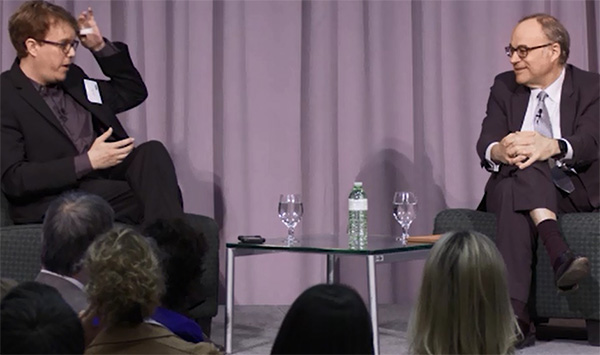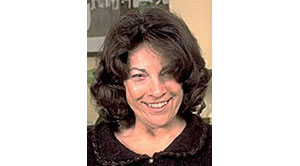If you see a guy holding a white hockey puck to his forehead, that’ll be Jesse Hirsh. If you see a guy checking his heart rate on his watch, that’ll be Ed Brown.
At OTN’s fabulously successful March 30 Hackathon, Jesse interviewed Ed about the future of connected, virtual health care. The first topic on the agenda was the engaged patient. That segued rather quickly to comparisons of personal health monitoring devices. Jesse showed the audience his Scanadu Scout. It looks like a hockey puck and measures blood pressure, heart rate, temperature and blood oxygen levels, sending the data to your iPhone. Ed, who has a Peak Basis watch that monitors heart rate, among other things, pulled out his smart phone, calling it the medical device of the future.

Jesse Hirsh and Ed Brown at OTN's Hackathon at MaRS Discovery District on March 30, 2015.
But, as they both pointed out, these devices collect a remarkable amount of data that our health care providers can do nothing with.
Here’s the interesting thing: That doesn’t stop consumers from buying these devices in the millions. In fact, International Data Corporation, a leading market intelligence company, predicts that, world-wide, 100 million fitness and medical health devices will be sold annually by 2018.
Given the fact that only two of the three necessary ingredients for turning this trend into better health are in play – the people are ready to be engaged and we have the technology but, with the exception of a few examples like OTN’s Telehomecare, the data is going nowhere – what’s the point?
For the individual, it’s what Jesse Hirsh calls the power of feedback. We are, by nature, comparers, even if only with the person we were yesterday. We like to measure stuff. Most of us are achievers. We want to be better than we were. We believe we can be. Our new wearable or cell phone can tell us how. And that’s new in the world.
Considering that much chronic disease in self-inflicted, this is surely a good thing. If personal monitoring devices nudge us toward prevention, we’ll individually be better off, even if our doctor can’t track our data.
... these technologies will eventually help shift us away from a fragmented system that is organized around the healthcare provider to one that is organized around the connected, engaged patient.
More, as Ed pointed out at the Hackathon, these technologies will eventually help shift us away from a fragmented system that is organized around the healthcare provider to one that is organized around the connected, engaged patient. By 2020, according to Deloitte UK, wearable devices will be interoperable, integrated, engaging and outcomes focused. The technology will become much cheaper and more sophisticated and the data quality will improve. And our wearables will continuously monitor a broad range of physiology from posture to brain activity, measuring quality of life, not just clinical indicators.
I can hardly wait. Meanwhile, if you see a woman tapping the black band on her wrist, that will be me.






